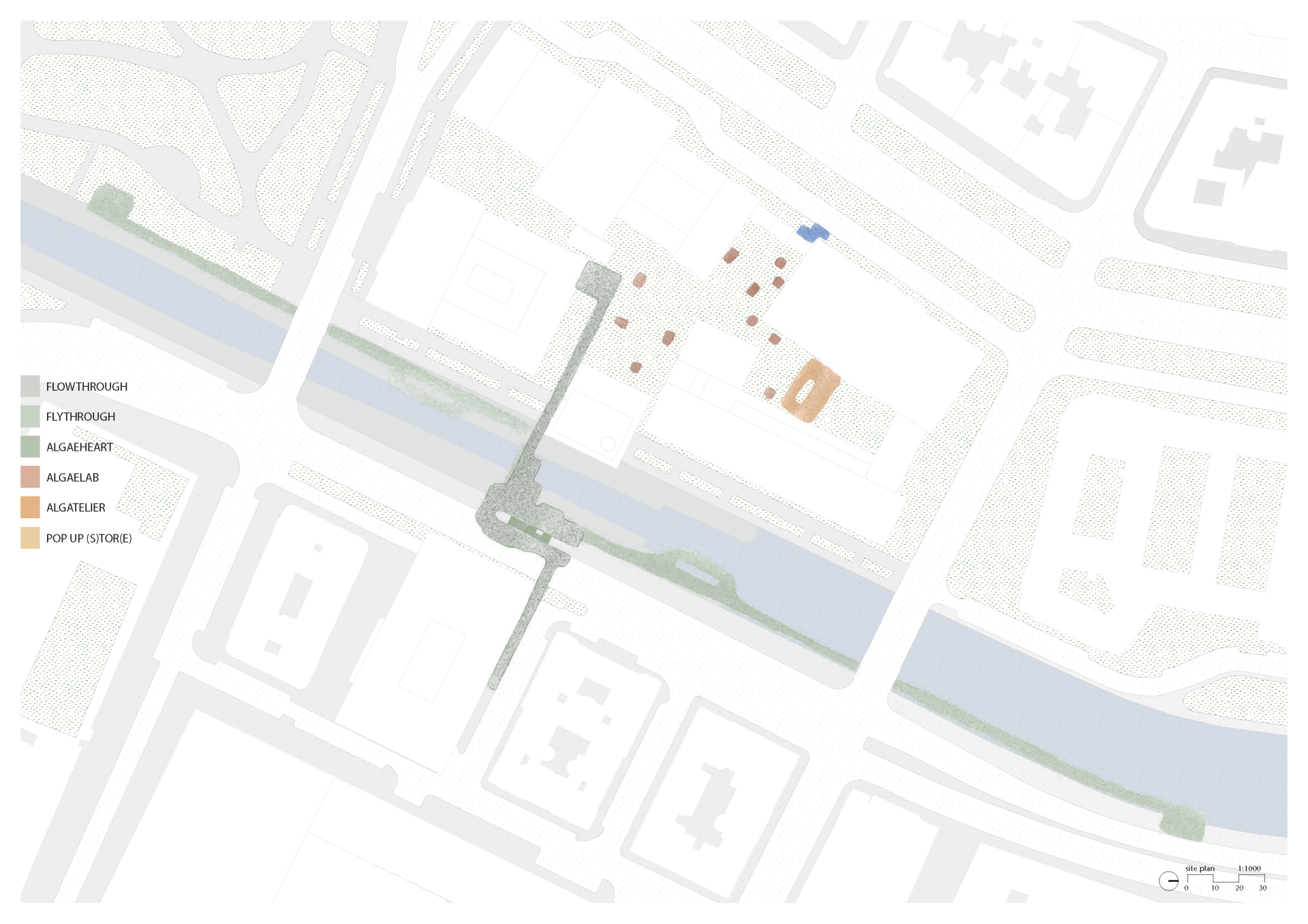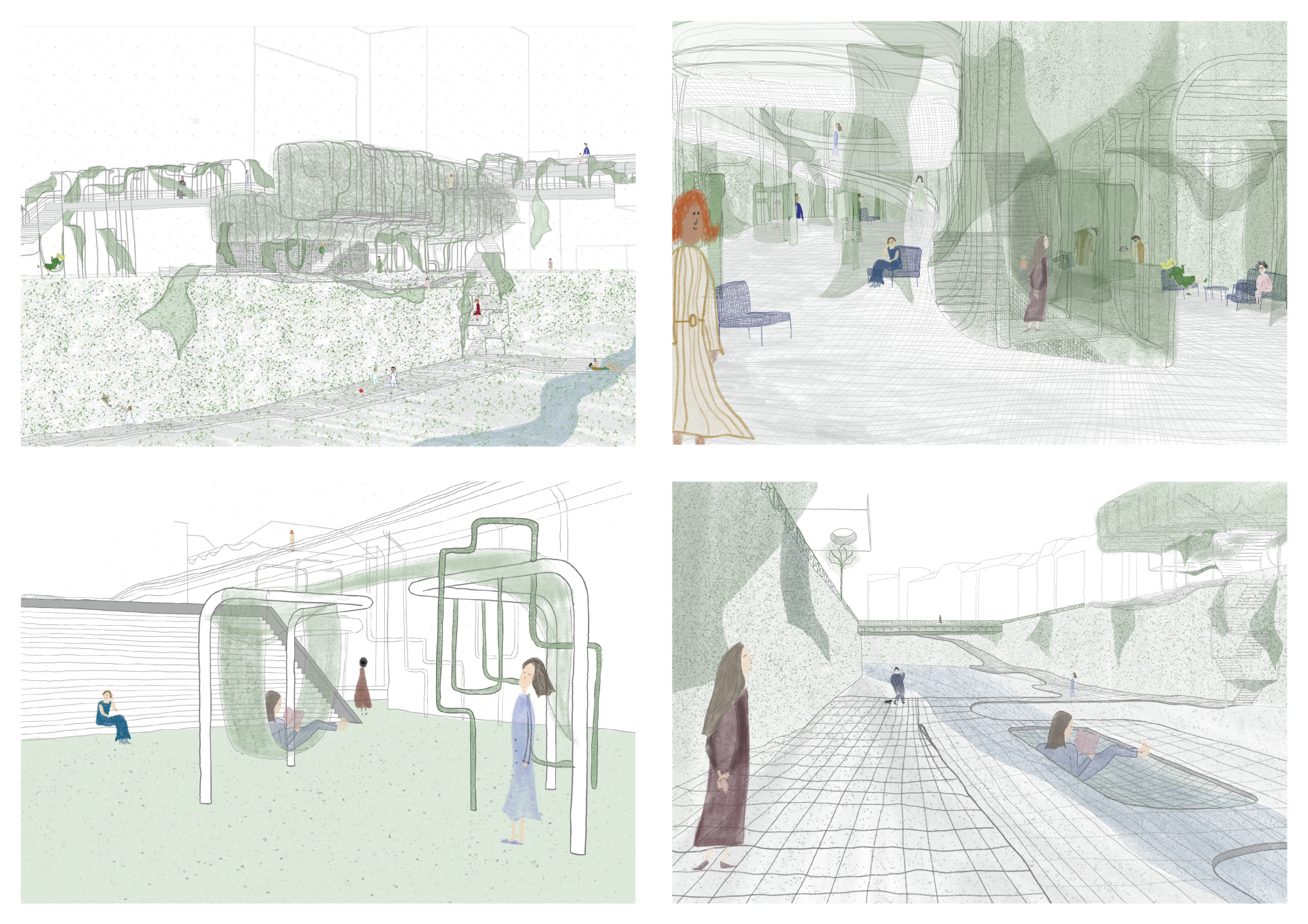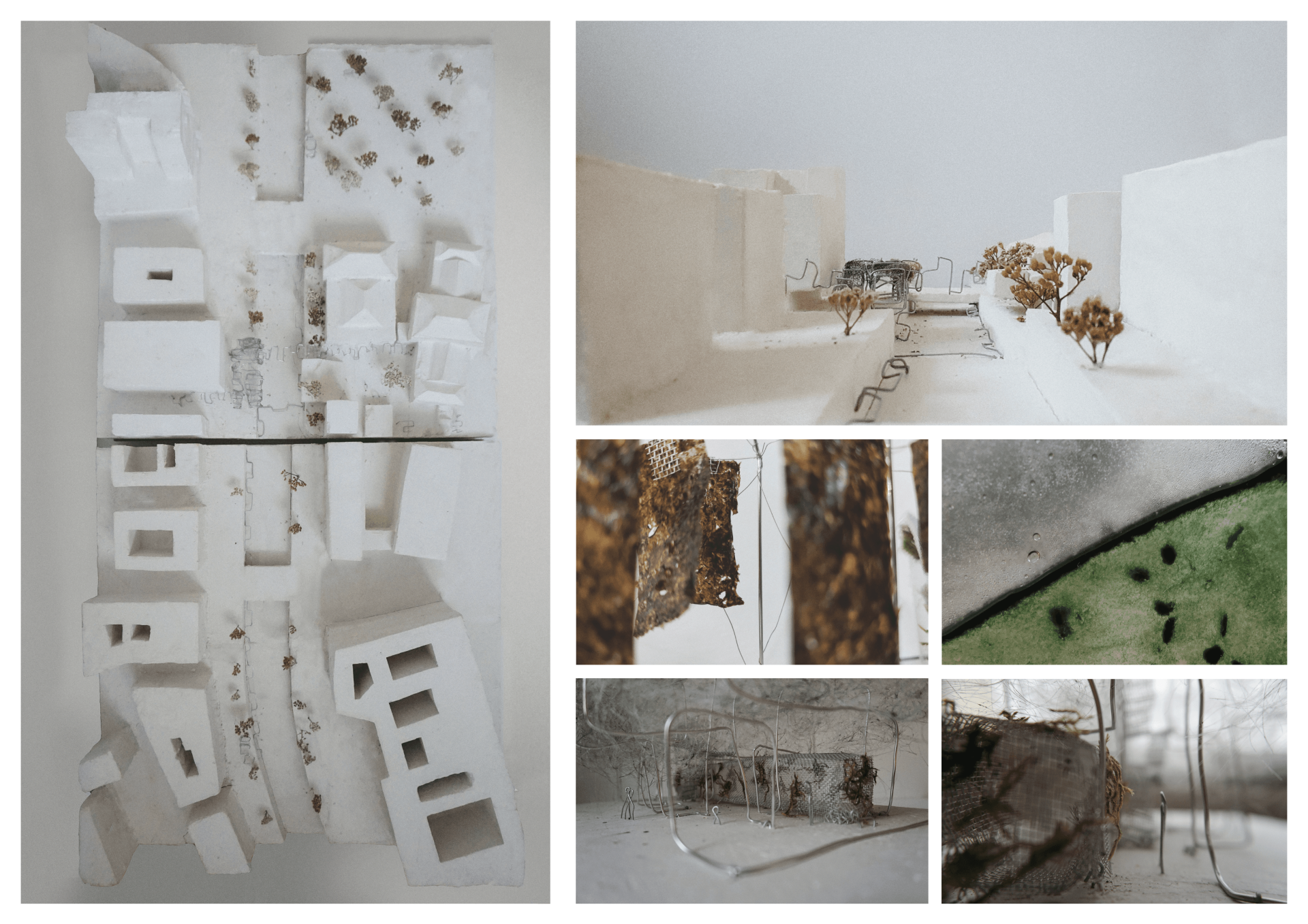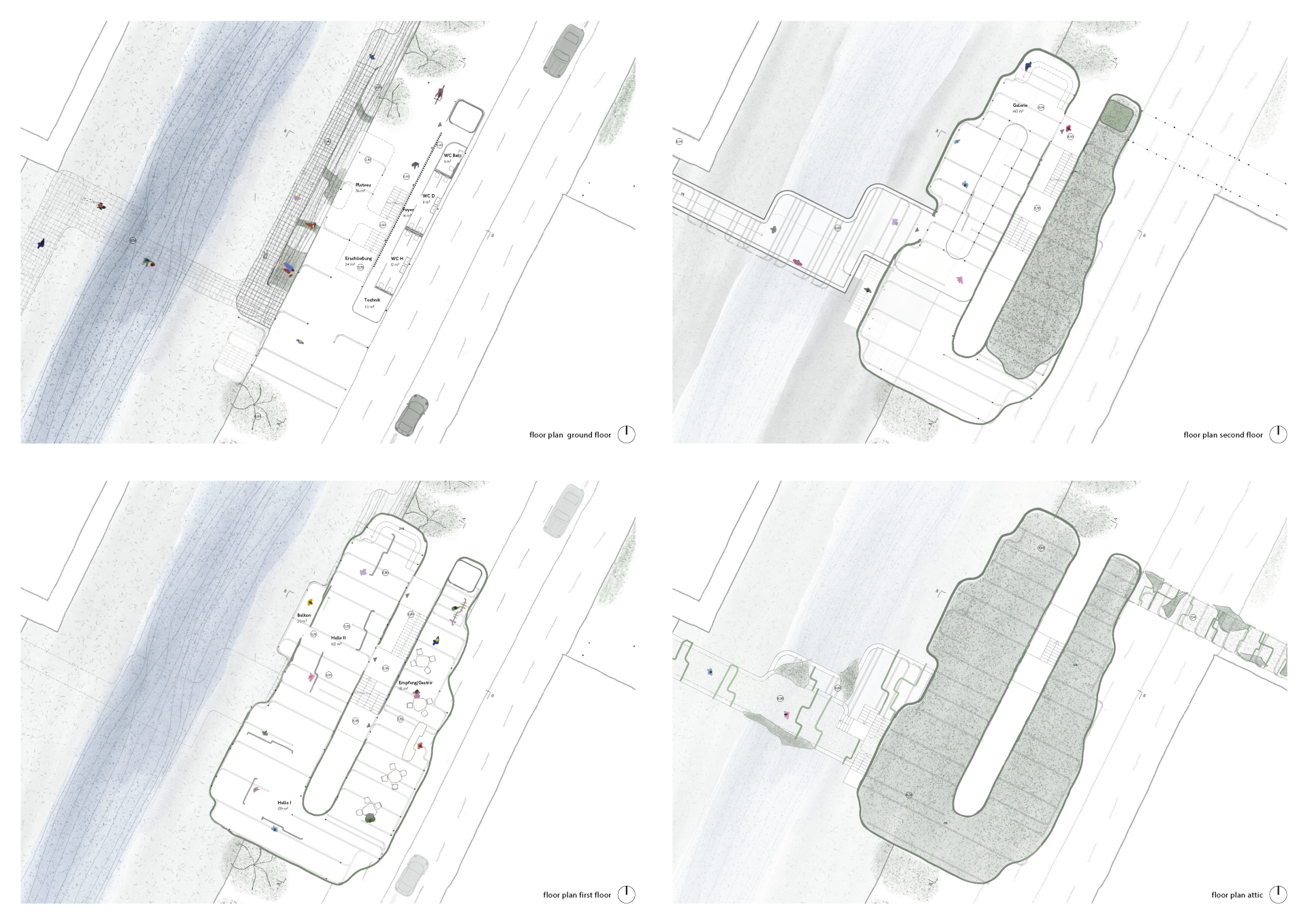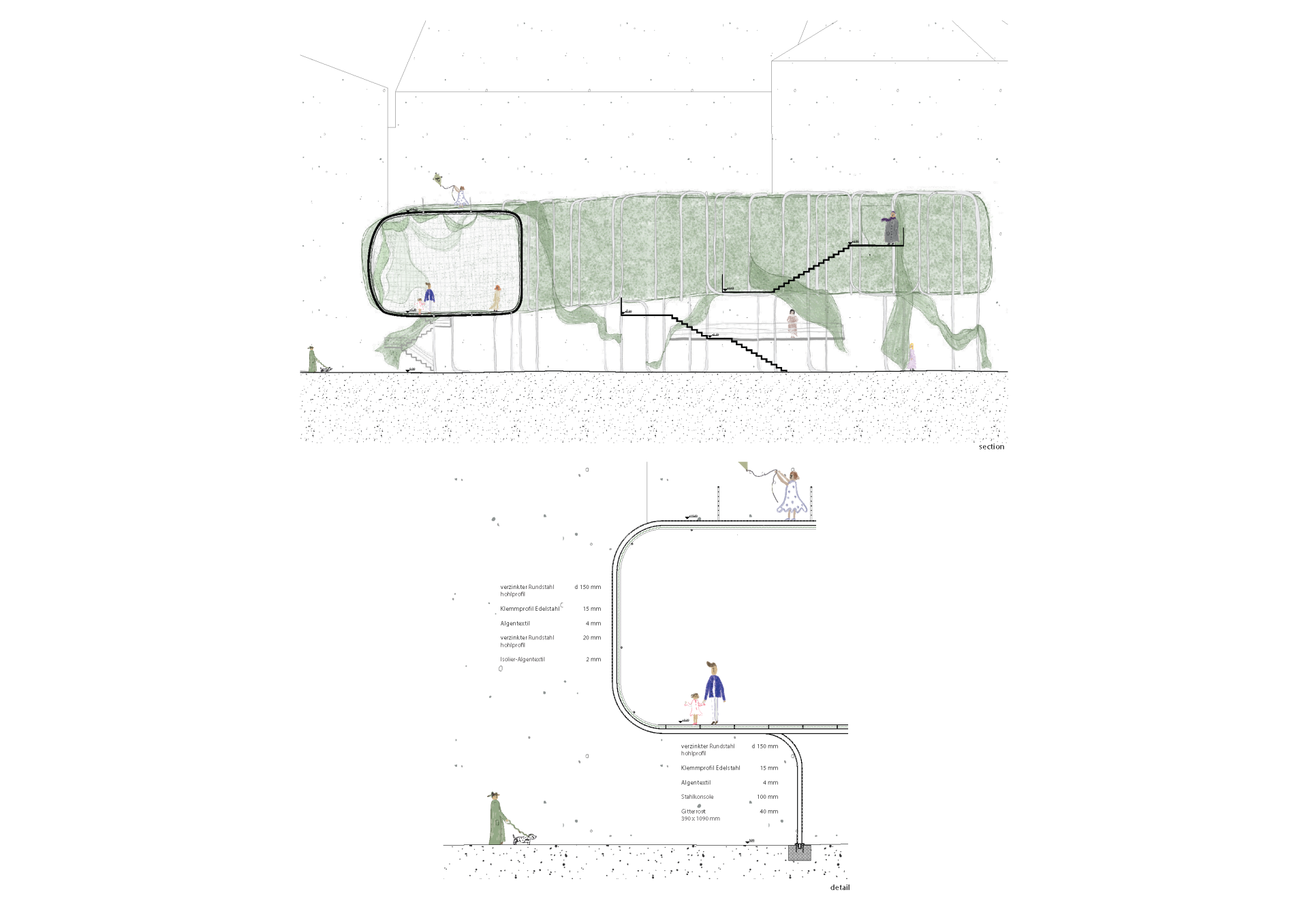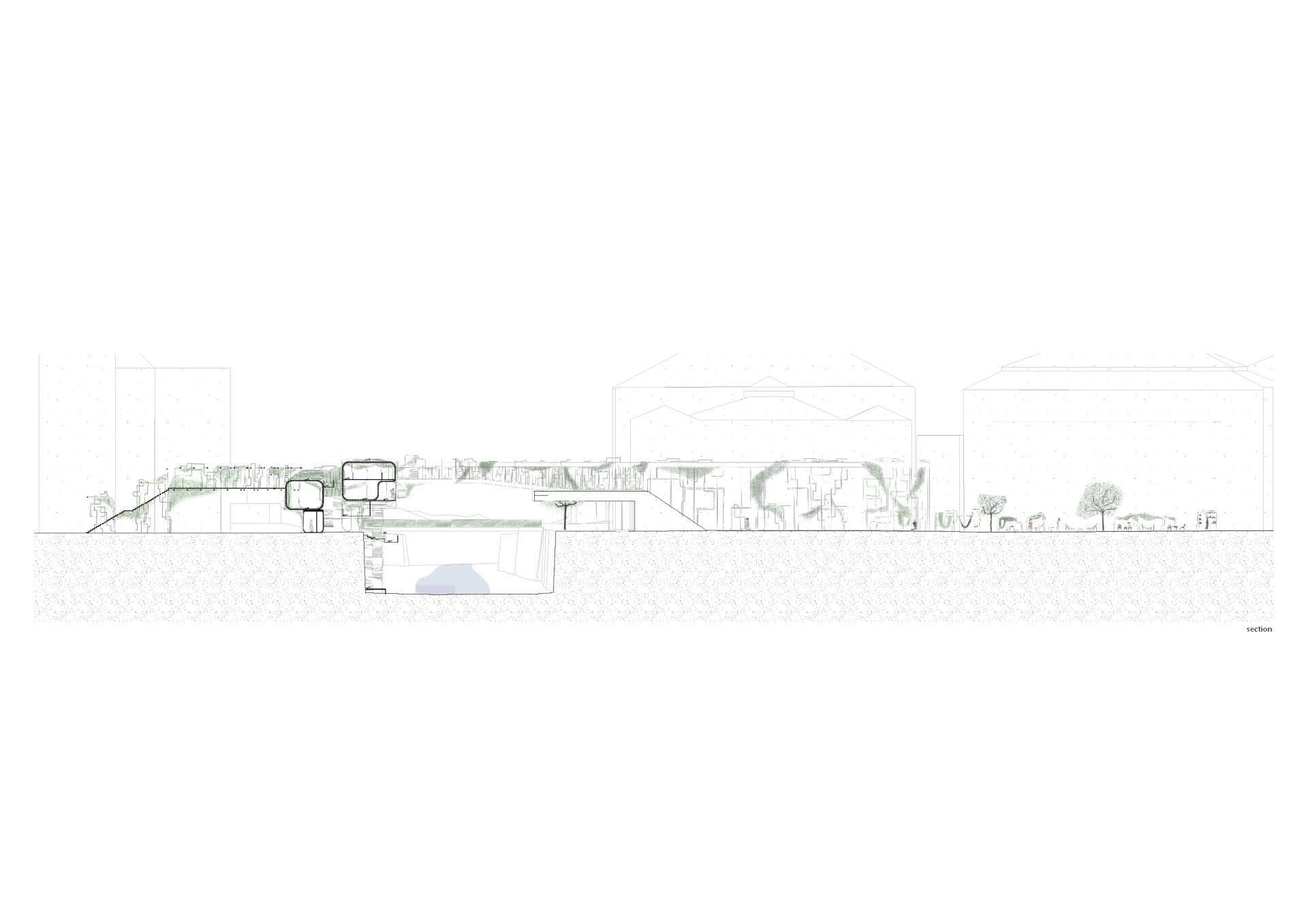ALGAECULTURE
Basic information
Project Title
Full project title
Category
Project Description
The ALGAECULTURE is about trespassing grounds with the power of algae. In the heart of Vienna, all needs seem to be fulfilled - cultural institutes, the closeness to the city park, the developed infrastructure and the beautiful view by the Wien river. However, one has the impression of a lifeless area, which suppresses the prevailing forces of nature and human desires. Our answer is the opening of spaces, respecting the flora and fauna and an architecture that creates balance.
Geographical Scope
Project Region
Urban or rural issues
Physical or other transformations
EU Programme or fund
Which funds
Description of the project
Summary
The project ALGAECULTURE is about trespassing grounds with the power of algae. In the heart of Vienna, in the 3rd district, all needs seem to be fulfilled - a variety of cultural institutes, the closeness to nature of the city park, the developed infrastructure of the mobile city and the wonderful view offered by the river bed of the Wien river.
However, one has the impression of a lifeless area, which suppresses the prevailing forces of nature and human desires.
Our answer is the opening of themspaces, respecting the flora and fauna and an architecture that creates balance. The choice of materials for the project reflects on the suppressed forces of nature and how they can emerge. Such a phenomenon is e.g. the corroded steel, or the stone overgrown with moss. By means of these elements, new places for appropriation are created in the urban space. By their various manifestations the algae restructure the urban space, respectively they overgrow it.
The previously minimalized pedestrian zones gain new areas in the river area, or in the previously unused niches of the surroundings. By expanding horizontally and vertically, locations with different qualities are created.
The public functions, such as therapy, art, education and culinary, are to intervene in the previously isolated open areas such as the MAK courtyard and create new connections. In order to bring a significant change in the until now underutilized, or private niches of the area, the spatial program was distributed to a wide area. The satellites in the urban space are united by their form and materiality.
These places meet in a multi-storey center, which is a multifunctional building, with a closed and open part. In order to ensure protection against environmental influences, a waterproof algae textile is used as the building envelope in combination with bent steel tubes as the supporting structure. These are then rigidly integrated into the existing concrete floor.
Key objectives for sustainability
Our project focuses on algae, which can be found naturally in the environment we choose as a starting point to realize our ideas. We are not trying to manipulate them to be more resistant or long lasting. We are observing their natural habitat and inserting those in an architectural shape. The idea is based on algae living in Wienfluss. In the concrete riverbed, flowing through the city center, it is hard to find natural wildlife. Only algae can survive and purify the air unnoticed. We react to this natural phenomenon by the renaturalization of the river and its surrounding area. New architectural trends often deal with the exploration of new materials, but instead of applying their spontaneous behavior, they force them into a particular form. We want to show that circularity and decomposition of materials can bring new qualities into architecture.
Key objectives for aesthetics and quality
Nature is aesthetic and atmospheric in itself, even in its untouched state. It is the basis of existence, life and circulation.We think that humans and nature are equal forces of the earth that should be living in harmony. Today the natural atmosphere around the Wien river is deprived, nature has no chance to develop because of all the human forces. Nature should play a role in built architecture, not only because we live from it, but also because existing without it, is like living without senses or emotions. Algae are naturally present around the Wien river, there would be many more of them if man did not suppress them. This area should be inspired by nature with its own aesthetics and harmony, "grow out of the site" and be unique. The algaetextiles and curtains play a major role in creating all these atmospheres in the project. With their ease and lightness, they are having an effect on human beings, they impact our bodies. The cooperation between algae and all natural elements such as sunlight, air, wind, water, humidity, etc. determines the beauty of the project. The spirulina tubes in the entire area also want to symbolize the organic architecture, like an organism unfolding from the seed. That is also where aesthetics, the quality of experience and functionality meet. The tubes are present throughout the area and their green color suggests growth. Feel nature and see the incredible variety of shades of green expressing renewal and life. Green evokes a feeling of abundance and is associated with refreshment and peace, rest and security. Algae are organic substances, filling by the fact that they can grow almost everywhere and thus fill empty spaces, they have a space-creating effect through their space-dividing and connecting function as textiles, their function as mediators the idea of sustainability makes them social, and they are circular due to their biological existence.
Key objectives for inclusion
The project is universal in the sense that it does not address a single user community, but is open to everyone and provides equal opportunities. This means that no one is excluded physically and intellectually. In order to provide equality several levels need to be considered. The urban location is next to a transport hub with access to the building by ramps and lifts from all directions. At the same time, these connections offer the opportunity to quickly reach points that were previously difficult to reach, thus increasing pedestrian traffic in the environment previously dominated by cars. The structure also leads in the garden of the Museum of Applied Arts, which is currently closed for both the public and visitors, standing therefore as an unused green space in the dense city. The goal is to create real communication between those who walk by, to recognize and then become better acquainted with the power of the nature around them, and to rethink this project, by experimenting themselves. The shape of the building is accordingly not bound, open to change, the primary cause of which is nature itself. A simple, renewable, and inexpensive metal support structure provides the framework, whose main purpose is to make room for different installations made of algae
Results in relation to category
The project can also be seen as a kind of green concept, which is an increasingly central theme in architecture today. As a first point, it should be noted that the use of algae as an environmentally friendly building material is not in itself mainstream. The algaeculture is an innovative, natural concept, where, unlike the current conventions such as green façades, green roofs, etc. a different, more sustainable, practical, space-saving and sustainable approach is being developed. The project reflects the very strong heat effects in the city centre, presenting a new method of air purification to the public, circular, self-sustaining, renewable and fully functional in winter, (when the algae are less photosynthetic) thanks to the simple steel support structure. It is adaptable to the needs of the present, it allows for change, flexible and is determined and powered by nature.
How Citizens benefit
We started working on the project in October 2021, for the time being mainly on a theoretical level. Already in the initial phase, we contacted institutes and individuals dealing with algae, such as the Weizmann Institute of Science, to seek their expertise. In addition, we did some simpler experiments ourselves. One of them was setting up a home algae farm. We would continue these experiments in the future, learning as many aspects as possible about algae and their possible use in architecture. This process of observing and experimenting is a key factor in a project like this. In order for the project to evolve and take shape, we would build models and prototypes on an ever-increasing scale, in different configurations. In the next step, we would build a pavilion in a 1: 1 ratio, and place it near to the water in order to benefit from the natural medium of algae. One of the goals of the project is that the elements can be extended and repeated anywhere, easily built by a community
Physical or other transformations
Innovative character
Environmental sustainability, aesthetics, quality of experience and inclusion are reasonably complementing each other in our project. The environment and the buildings that are designed from and with algaes are more than sustainable because they produce energy with zero emissions meanwhile they clean the air all around the area. Apart from the simple metal support structure, the project is living from itself, forms and shapes itself and does not need any other materials to exist and function. The algae area is in the center of Vienna, is connected with many forms of public transport lines even with the train coming from the airport, is next to a large parking garage, open and easily accessible to all on foot, by bike or even with a stroller. The bold, algae-infested structures attract everyone's attention and the aesthetic, attractive, eye-catching greenish-blue creatures draw their attention. Our project is also exemplary because it takes place in a density and crowded area, where no one see the opportunity for similar initiatives, or even recognise the need for such a thing - this place is a traffic zone, cars, trucks, buses, pedestrians want to pass through the area as quickly as possible, to leave it, they only consider it as a motion zone. The algaeculture is also designed to make the city and the district a better place, both in terms of sustainability, appeal and inclusion.

